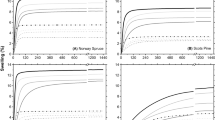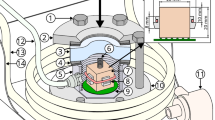Abstract
Volume changes due to modification with acetic and hexanoic anhydride are due to the volume occupied by the reagent and an associated void volume. The void volume is larger in hexanoic anhydride modified wood. Less weight of water per gm of unmodified wood was accommodated by acetic anhydride modified wood than by hexanoic modified wood, at equivalent WPG. A non-linear relationship was found between weight of water per gm of unmodified Corsican pine wood and bulking, whereas a linear relationship would be predicted. However, this takes no account of void volume. When the value of void volume is deducted from the bulking a linear relationship was indeed obtained with acetic anhydride, but not with hexanoic anhydride modified Corsican pine. It seems therefore that the free volume model offers a reasonable explanation of the differences in swelling recorded for Corsican pine sapwood modifying to varying wpg’s with acetic anhydride.
Zusammenfassung
Volumenänderungen aufgrund einer Modifikation mit Essig- und Capronsäureanhydrid beruhen auf dem Volumen, das die Rektanten einnehmen sowie dazu gehörigen Leerräumen. Letztere sind größer im Fall der Modifikation mit Capronsäure. Das mit Acetanhydrid modifizierte Holz nimmt pro Holzmasse weniger Wasser auf als das mit Capronsäure modifizierte, bezogen auf die prozentuale Massenzunahme (WPG). Eine nicht-lineare Beziehung ergab sich zwischen Wasseraufnahme und Volumenzunahme pro Gramm für nichtmodifiziertes korsiches Kiefernholz, wofür eine lineare Beziehung zu erwarten wäre. Dabei ist allerdings nicht das Volumen der Leerräume berücksichtigt. Wird dieses von der Sperrigkeit abgezogen, so ergibt sich tatsächlich eine lineare Beziehung nach der Modifikation mit Acetanhydrid, nicht aber mit Capronanhydrid. Es scheint also, daß das Modell der Leerräume eine vernünftige Erklärung liefert für das unterschiedliche Quellverhalten, das an korsischen Kiefern-Splintholz beobachtet wurde.






Similar content being viewed by others
References
Hill CAS, Jones D (1996) The dimensional stabilisation of Corsican pine sapwood y reaction with carboxylic acid anhydrides. The effect of chain length. Holzforschung 50:457–462
Hill CAS, Jones D (1999) Dimensional changes in Corsican pine sapwood due to chemical modification with linear chain anhydrides. Holzforschung 53:267–271
Hill CAS, Papadopoulos AN (2002) The pyridine catalysed acylation of sapwood and phenolic model compounds with carboxylic acid anhydrides. Determination of activation energies and entropy of activation. Holzforschung 56:150–156
Nakano T (1988) Viscoelasticity of esterified wood specimens (5). The effect of molar volume of introduced acyl groups. Mokuzai Gakkaishi 34:516–521
Nakano T (1994) Mechanism of thermoplasticity for chemically modified wood. Holzforschung 48:318–324
Papadopoulos AN, Hill CAS (2003) The sorption of water vapour by anhydride modified softwood. Wood Sci Technol 37(3–4):221–231
Papadopoulos AN (2001) Swelling, cell wall porosity and chemical modification of wood. Ph.D Thesis, University of Wales, Bangor
Risi J, Arseneau DF (1957) Dimensional stabilisation of wood. Part I: Acetylation. Forest Prod J 7:210–213
Rowell RM, Ellis WD (1978) Determination of the dimensional stabilisation of wood using the water soak method. Wood Fibre Sci 10:11–18
Siau JF (1995) Wood: influence of moisture on physical properties. Department of Wood Science and Forest Products, Virginia Polytechnicin Institute and State University
Skaar C (1988) Wood-water relationships. Springer, Berlin Heidelberg New York
Stamm AJ (1964) Wood and cellulose science. Ronald Press Co, New York
Stamm AJ, Tarkow H (1947) Dimensional stabilisation of wood. J Coll Chem 51:493–505
Author information
Authors and Affiliations
Corresponding author
Rights and permissions
About this article
Cite this article
Papadopoulos, A.N., Hill, C.A.S. & Gkaraveli, A. Analysis of the swelling behaviour of chemically modified softwood: A novel approach. Holz Roh Werkst 62, 107–112 (2004). https://doi.org/10.1007/s00107-003-0448-8
Published:
Issue Date:
DOI: https://doi.org/10.1007/s00107-003-0448-8




